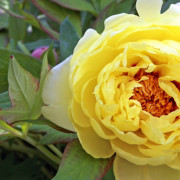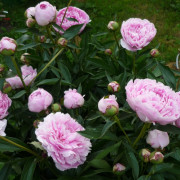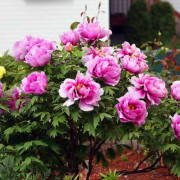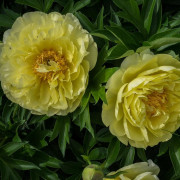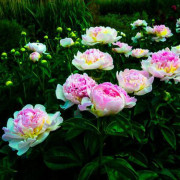Peony Ann Cousins (Paeonia Ann Cousins) - description of the variety
Content:
Peonies are charming flowers, garden decoration. In America there is the Society of Peonies (AMOP), in the capital of Russia there is a club called Flower Growers of Moscow with a section called Peonies. Few representatives of the flora are honored with such an honor. Among the large number of plant varieties, Anne Cousins' peony occupies a special place.
Peony Ann Cousins (Paeonia Ann Cousins) - what kind
"Flower growers of Moscow" awarded the peony Ann Cousins a prize in the category "Milk-flowered white varieties." This is an intraspecific variety. Originator Gilbert H. Wild & Son bred it in 1946. Since then, this herb of the Peony family pleases gardeners with a milky creamy color.
The flower has been domesticated for so long that you can no longer find it in the wild. Southeast Asia is considered the birthplace of the peony. It grows in the southern, middle and northern latitudes of all continents.
Description, characteristics
The Anne Cousins peony flower is the late blooming of the family. Features of decorative culture:
- Rhizome multi-headed with fusiform roots.
- Stems are thick, resilient, long. They grow up to 90 cm. They tend to bend, require support.
- The leaves are dark green, attached to the stem with stalks. The width and length of the double-triple-divided plates are 25-30 cm. The lobes have an elongated lanceolate shape.
- The flower is densely double, has a beautiful rosy shape. The bud is composed of rounded petals of the same size. To the center, they are compactly collected, velvety in appearance. The flowers are heavy, large, up to 20 cm in diameter. The greenish buds gradually turn creamy. Then, when blooming, the color changes to pure white. In the very core, a faint light green color with a light yellow color is visible. It emphasizes the flawless whiteness of the petals.
- The aroma is fresh. Not a strong smell reminiscent of sweetish strawberries with tart cherries. Connoisseurs also find raspberry notes.
- The fruits are leaflets. In each of them, black shiny seeds ripen, suitable for breeding.
Anna pion flower does not have stamens and pistils, it grows slowly. The plant tolerates frosts well in the Moscow region, the Urals, and the mountainous regions of Scandinavia.
Growing a flower
Once planted peony Ann Kusins lives in one place for 8-10 years. Shows varietal qualities in the second or third year. Until that time, it is not transplanted.
Site and soil selection
Since the culture grows for a long time in a designated corner of the garden, front garden, the place for it is carefully selected. The dense shade and the neighborhood with fruit trees are not suitable for a peony. Cold drafts, close distance from buildings and blind fences are also not the best place.
Choose a site that is ventilated, sunny, or with diffused shade. The sun should hit the peony 6 hours a day. The ideal soil option is cultivated loam. Slightly acidic soils are suitable. If the acidity of the soil is higher than pH 6-6.5, then it is deoxidized with lime or ash. When the groundwater comes close to the surface, the roots rot out, so it is better to choose a hillock.
Before planting, the site is dug on a shovel bayonet, weeds, debris, stones are removed. The earth is loosened and allowed to "breathe".
Seed selection
The peony is planted with rhizome cuttings. They are bought in specialized places. The material is not cheap, so they take healthy-looking rhizomes. They should be juicy, fresh, thick. It is good when there are many small roots. Material with black spots, traces of rot and fungus is not taken.
Boarding time
Florists are advised to do this in the fall, when the flower is in a dormant period. In fertilized soil, even before frost, it will take root. Before winter, it is enough to mulch the seedling or cover it with burlap. After the snow melts, the shelter is removed as early as possible - the buds quickly start growing.
If it was not possible to plant a peony in the fall, it is planted in the spring. But the rehabilitation period is greatly delayed. The weather is chosen warm when the ground is completely thawed out. Night light frosts are not terrible for the plant.
Procedure step by step
The finished parcel of paeonia Ann Cousins is planted in open ground as follows:
- Dig a cone-shaped hole. Diameter 50 cm, depth 60 cm.
- The bottom is covered with a drainage layer (expanded clay, stones, gravel).
- The dug earth is mixed with compost, dolomite flour (100 g), ash (3 glasses). 200 g of superphosphate and potassium sulfate (70 g) are added thereto.
- The pit is filled with earth so that 15 cm remains to the edge.
- In the middle there is a divider.
- The roots are covered with earth along with the buds. They should be 5 cm deep.
- Carefully crush the soil, water it.
- Mulch the method of planting with improvised materials (sawdust, peat).
Agrotechnical cultivation
Caring for the culture is uncomplicated. The peony will grow even without supervision, but so that the flowers are large and decoratively attractive, the bush is moderately watered before and during flowering. After that, they are waiting for the soil to dry 5 cm deep - overflow can rot the root system.
Pruning consists of removing faded buds. The stems and flowers are heavy, so props are placed near the flower.
In the first two years, the plant is not fertilized. Then, in the spring, together with watering, 20 g of superphosphate are added to build up the green mass. At the time of flowering, the peony is fed with potash fertilizer.
Weeding and loosening will prevent weeds from growing and provide oxygen to the roots.
Peony Ann Cousins in landscape design
The culture is used in gardens, parks, and alpine slides. The peony looks good as a lonely bush. Especially against the background of a green lawn or near the steps to the house, garden gazebo. It is an independent decorative element.
The borders of white peonies are spectacular. The plant blooms by the end of July, when its brothers have already faded. Paths framed with such flowers will delight you until autumn.
In the group, the peony is combined with red and yellow representatives of the species or with other families with different flowering periods (lilies, hosts, primroses). Bulbous flowers are planted between the bushes. When they bloom, the dried stems are cut off. Peony with wide leaves decorates this place perfectly.
Reproduction
Peonies are bred by dividing the bush. This is done at 4-5 years of plant life, when it has at least 7 shoots. Divide the bush at the time of planting.
Peony roots are fragile, so the plant is dug up with a large clod of earth. It is shaken off, the roots are allowed to dry, the tops are shortened to 15 cm. Then the root is divided into sections with a knife. Each should have 2-3 shoots and 3 growth buds. Immediately after dividing, parts of the rhizome are planted in new places.
Propagation by root cuttings is a long way. A piece of rhizome with a bud at the base of the stem is separated from the bush, rooted in the garden bed. You do not need to cover with cans and bottles. The seedling is looked after, watered, loosened the ground. They wrap him up for the winter. With a good outcome, the plant will develop by the age of five.
The Ann Cousins peony is the most beautiful of its kind.It is important to plant an unpretentious plant correctly - choose a place and seedlings. The culture grows slowly, blooming in the second or third year. A peony lives in one place for decades. Top dressing, watering, and loosening of the flower are carried out as part of the usual care. Pests do not touch the bush, the peony is resistant to disease.











